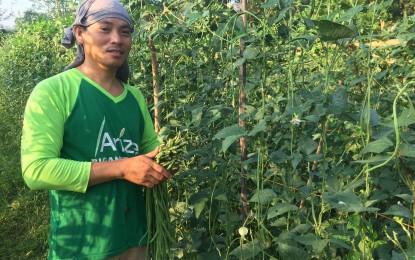
ORGANIC FARMER. Lyndon Madrid, a farmer from Dingras, Ilocos Norte, grows string beans and other high-value crops such as corn, papaya, and pepper. He uses a mixture of carbonized rice hull, animal manure, and organic fertilizer to improve the fertility of his farmland. (PNA photo by Leilanie Adriano)
LAOAG CITY – Another batch of 1,000 farmers received a soil fertility package covering 250 hectares last week in the continuing soil restoration program of the Ilocos Norte government.
For every hectare, the local government provides at least 20 sacks of organic fertilizer, urea (nitrogen fertilizer), and gypsum (soil conditioner) to help rehabilitate farmlands and boost production efficiency.
Soil experts say agri-gypsum is a good source of calcium and sulfur and improves soil characteristics. It helps soil better absorb water and reduces erosion.
“This is enough to restore the soil fertility if we get the appropriate measure for every hectare. That is why we are asking our farmers to do their share,” Edwin Cariño, head of the Sustainable Development Center, said during the March 16 ceremonial distribution at the Rizal Park here.
Cariño said the soil restoration program started during the term of then-governor and now Senator Imee Marcos. It aims to cover all agricultural farmlands in the province.
After catering to farmers in Adams, Dumalneg and Carasi towns, the Ilocos Norte government will also reach out to areas with high acidity levels due to excessive use of inorganic fertilizer.
Former farmer-beneficiaries of the program attest that their harvests increased by 20 to 30 percent since they shifted to organic farming.
As a producer of high-value crops like string beans, ampalaya, Chinese pechay and papaya among others, Lyndon Madrid, an organic farmer from Dingras town, said taking good care of the soil has been working wonders.
“It pays to have a good soil. It defines the quality of your harvest. And if you apply organic, the more you get benefits from it,” he said.
Madrid uses a mixture of carbonized rice hull, animal manure and organic fertilizer to improve the fertility of his farmland. Nothing is discarded as he converts all wastes into organic fertilizer.
Aside from reducing the cost of farm inputs and producing healthier food, the local government continues to encourage farmers to adopt organic farming.
A color-coded soil fertility map was created in the province, which is now being used by farmers to determine the level of soil fertility and what to do about it. (PNA)
